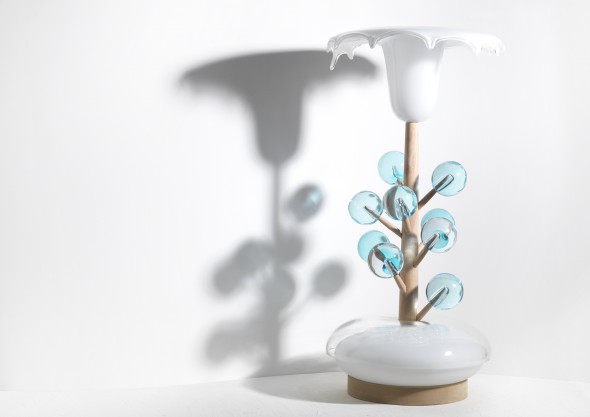Interview by Alena Sokhan in Berlin // Friday, May. 01, 2015
A pop-up Gallery has appeared in Berlin, just off Potsdammer Straße, which is run by the oldest existing Champagne House, Ruinart. The brand has a history of supporting the arts: this year Ruinart commissioned sculptural works by French artist and designer Hubert le Gall, on display from May 1-3. Famous for his elegant and whimsical furniture designs, le Gall chose to produce 12 delicate glass and wood artworks for Ruinart, titled Le Calendrier de Verre. Each artwork represents a stage in the process of champagne making, forming a sculptural calendar of works that are charged with the labor and growth involved in each month. As the final touches were being done for the vernissage, we had a chance to talk with Hubert le Gall: a poised but highly approachable character who spoke to us about work, art, baths and inspiration.
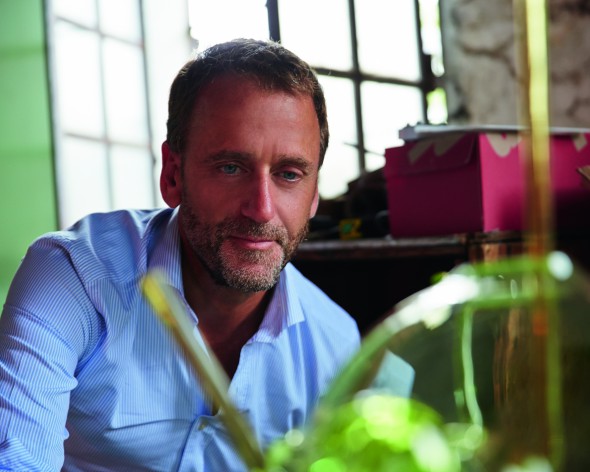
Hubert le Gall: ‘Calendrier de Verre’, 2015, collaboration with Ruinart Blanc de Blancs // Photo courtesy of Ruinart
Alena Sokhan: What was different or unusual for you about making these works for Ruinart?
Hubert le Gall: It is the first time that I made sculptures. I am more an artist who designs furniture, so having a function is very important for me. This is the first time that somebody asked me to make something that has no function at all.
It is still not so different from most of my work, because even though it has no function it does tell a story of human work. Also, in my furniture designs I am always telling a story, or saying something, that goes beyond the formal aspects of the work. In Le Calendrier de Verre, the inspiration came from the work of people on nature: the way that people tend to vines over the months which is about relating to and struggling against nature, trying to shape nature to do what we want and nature doing what it wants.
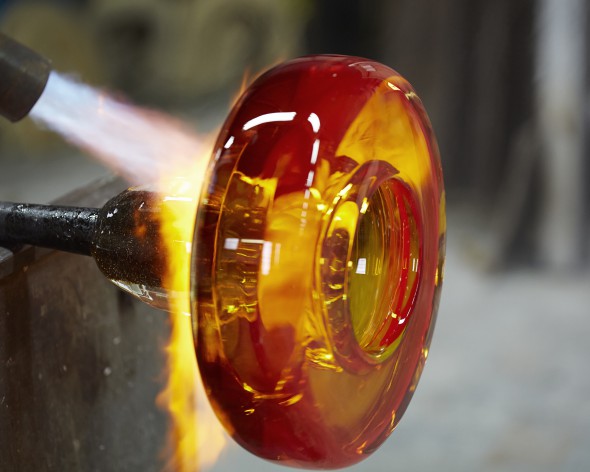
Hubert le Gall: ‘Calendrier de Verre’, 2015, collaboration with Ruinart Blanc de Blancs // Photo courtesy of Ruinart
AS: If it has no function, where else do you find the inspiration for your designs for Le Calendrier de Verre?
HG: Well in addition to the work of people on nature that we just discussed, the works are also about time: the time to wait, the time to grow, the time to open the bottle, and so on. So when Ruinart asked me to make a sculpture I told them that I prefer to make twelve smaller sculptures, its more interesting for me because I can better express my ideas about the growth of nature and progression of time. In some months you can see how the human labor dominates the form, in other months it is more about nature asserting itself.
I don’t want to make figurative works, I wanted a poetic expression of the vineyard. The process of wine making is a very ancient craft, it has not changed significantly over the last few centuries. And I noticed that this is quite similar to glass – it also has stayed almost the same for centuries. Glass has its own nature, too, it shows its imperfections and in certain ways resists being formed. I have kept these imperfections – bubbles and lumps. I think it is very appropriate that both glass and wine have in their very making and material a history of the human work on nature.
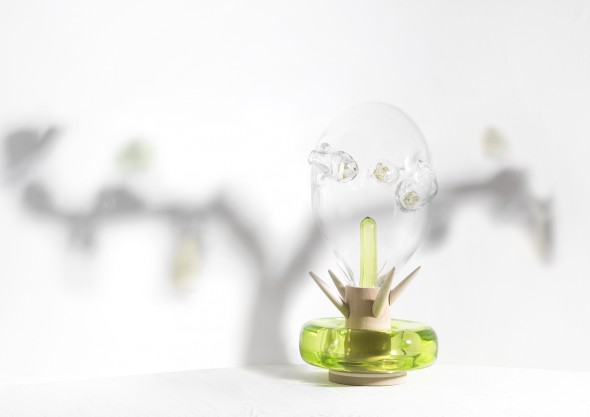
Hubert le Gall: ‘Calendrier de Verre’, 2015, collaboration with Ruinart Blanc de Blancs // Photo courtesy of Ruinart
AS: What is your relationship to your works? Especially your furniture works – are they just a functional object or are they artworks?
HG: Sometimes I make a table that is just a table. But my best works are more complicated. For instance I made a lamp called the Geode Lamp – it is a sculpture of a lamp, but it is also a lamp, since it still has that function. I would say art is my inspiration, both classical art and contemporary art, as much as decorative art.
I think Pop Art is an important movement: Pop Art takes ordinary things and makes them into art by taking out the function. What I like is to work with art and give it a function, which prompts the question that endlessly fascinates me: what is art?
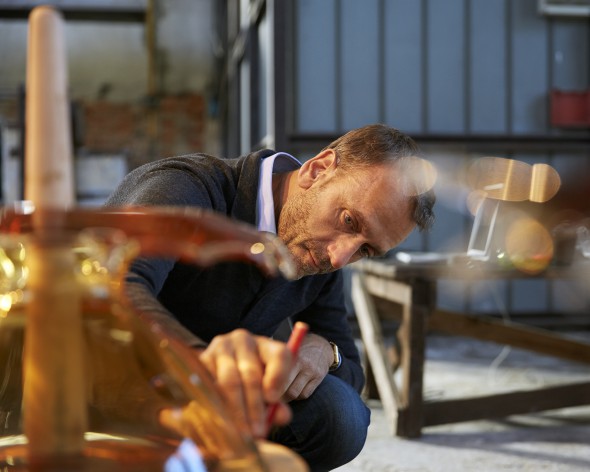
Hubert le Gall: ‘Calendrier de Verre’, 2015, collaboration with Ruinart Blanc de Blancs // Photo courtesy of Ruinart
AS: What is an ideal space for you to work?
HG:I have a studio in Paris, but I have two places that are the best for ideas and inspiration. The first is when I am travelling, in a plane, in a train. In this time my mind is very free, because I do not have my mobile phone, I don’t have assistants, I have nothing to do really. So it is very important for me to have a paper and pen in my pocket while travelling. The other place for inspiration is the bath. I take at least one bath, maybe two, each day, I find it very relaxing and meditative.
I don’t like simply doing the same thing so I am constantly looking for something new or different to change my work. I think these two places – travelling and the bath – are when I can be inspired, since I my mind can wander and I am not busy doing something like I am the rest of the day.
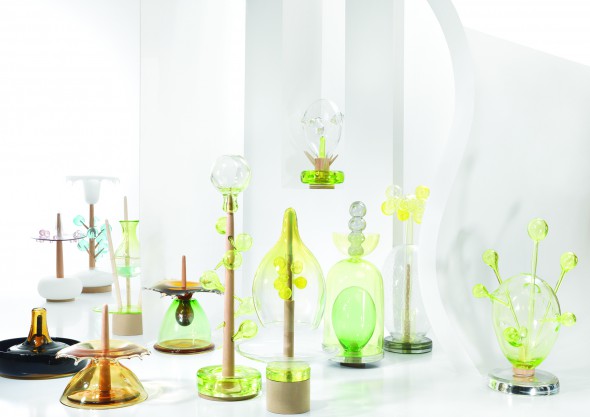
Hubert le Gall: ‘Calendrier de Verre’, 2015, collaboration with Ruinart Blanc de Blancs // Photo courtesy of Ruinart
AS: What are your reflections on the way your work has changed with this show at Ruinart, where you have made sculptures, which are quite different from your work before?
HG: This is a very important show for me because now I realize that I can be a sculptor. I always make sculpture with a function because maybe I do not want to call myself an artist. Now, having made works without function, I realize that I do not need function to justify my work.
I am very reflective and interrogative about this series. I am not sure if I will keep making furniture or sculpture, or sculpture that is furniture anymore, this is something I am thinking about now. Maybe I will always continue asking this question: am I an artist or am I an artistic designer?
Additional Info
RUINART POP-UP GALERIE
“Le Calendrier de Verre” – HUBERT LE GALLBERT
Exhibition: May 1 – 3, 2015
Opening Hours:
Friday, May 1; 12 – 9pm
Saturday and Sunday, May 2 and 3; 11am – 7pm
Potsdamer Straße 68, second backyard (click here for map)
Artist Website:
www.hubertlegall.wordpress.com


